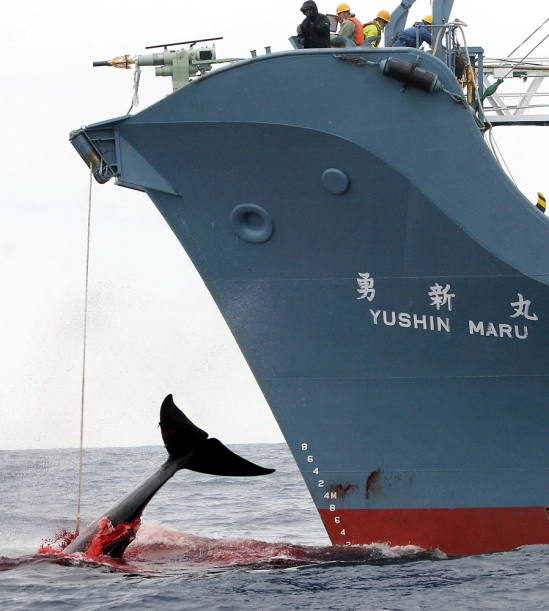15 of the Deadliest Corporations:

15 of the Deadliest Corporations
These corporations, if they were individual human beings, would be locked up for life. Instead, they continue raking in the big bucks. Human rights abuses, murder, war, eco disasters, and animal exploitation keep these evil companies raking in the green. Prepare to be disgusted.
Chevron

Several big oil companies make this list, but Chevron deserves a special place in Hell. Between 1972 to 1993, Chevron (then Texaco) discharged 18 billion gallons of toxic water into the rain forests of Ecuador without any remediation, destroying the livelihoods of local farmers and sickening indigenous populations. Chevron has also done plenty of polluting right here in the U.S.: In 1998, Richmond, California sued Chevron for illegally bypassing waste water treatments and contaminating local water supplies, ditto in New Hampshire in 2003. Chevron was responsible for the death of several Nigerians who protested the company’s polluting, exploiting presence in the Nigerian Delta. Chevron paid the local militia, known for its human rights abuses, to squash the protests, and even supplied them with choppers and boats. The military opened fire on the protesters, then burned their villages to the ground.

Diamonds are a girl’s best friend — unless she lives in the Ivory Coast. “Blood” or “conflict” diamonds are the name given to minerals purchased from insurgencies in war-torn countries. Prior to 2000 when the U.N. finally took a stand against the practice, DeBeers was knowingly funding violent guerrilla movements in Angola, Sierra Nevada, and the Congo with its diamond purchases. In Botswana, DeBeers has been blamed for the “clearing” of land to be mined for diamonds — including the forcible removal of indigenous peoples who had lived there for thousands of years. The government allegedly cut off the tribe’s water supplies, threatened, tortured and even hanged resisters.
Tyson
Even if you don’t care about the horrendous animal abuse that has been documented in Tyson’s factory farms, you have to flinch at Tyson’s appalling environmental abuses and workers’ rights violations, as well as the fact that on several occasions, Tyson has allowed e coli tainted beef to enter the food supply. A recent study showed that Tyson’s chickens were the most salmonella-and-campylobactor filled poultry of all the major suppliers. As if that wasn’t gross enough, Tyson has been sued repeatedly for illegally dumping untreated wastewater into Tulsa’s water supply; after they were sued the first time, they simply paid the fine and continued the practice. Tyson has made people seriously ill with the ammonia from their factory farms. Tyson is infamous for knowingly hiring illegal immigrants and has even been accused of human trafficking to supply themselves with cheap labor.
Smith and Wesson

As the largest manufacturer of handguns (and sub machine guns) in the U.S., Smith and Wesson is indirectly responsible for uncountable shooting deaths — not just by the police and government agencies to which these guns are issued, but by criminals and by “accident.” In a study of the top ten guns involved in crime in the U.S., the first was the Smith & Wesson .38 Special. Numbers 6 and 7 were also Smith and Wessons. Statistically, studies have shown that guns are used more often in crime than in self-defense. Of course, “Guns don’t kill people. People kill people.” And frequently, they use Smith and Wesson guns to do so.
Phillip Morris

Phillip Morris is the largest manufacturer of cigarettes in the U.S. Cigarettes are known to cause cancer in smokers, as well as birth defects in unborn children if the mother smokes while pregnant. Cigarette smoke contains 43 known carcinogens and over 4,000 chemicals, including carbon monoxide, formaldehyde, hydrogen cyanide, nicotine, ammonia and arsenic. Nicotine, the primary psychoactive chemical in tobacco, has been shown to be psychologically addictive. Smoking raises blood pressure, affects the central nervous system, and constricts the blood vessels. Discarded cigarette butts are a major pollutant as smokers routinely toss their slow-to-degrade filters on the ground. Many of these filters make their way into salt or fresh water bodies, where their chemicals leech out into the water. Then again, cigarettes make you look cool.
Haliburton

Any corporation that has Dick Cheney as a CEO has got to be evil. Haliburton, a huge “oilfield services” company, profited big time from the U.S.’s invasion of Iraq when Cheney called in his boys to quell burning oil wells — and to “help” the Iraq oil ministry pump and distribute oil. Haliburton has also been implicated in countless oil spills, including the BP disaster of 2010.
Coca Cola

America’s favorite soft drink, deadly? Well, even if you choose to overlook the childhood obesity epidemic and how soft drinks market to children to get them to buy something really, really bad for them, Coca Cola corporation has wrought devastation in India, where its factories use up to one million liters of water per day, leaving tens of thousands of nearby residents dry during the drought months. Then the factories dispose of the wastewater improperly, contaminating whatever water is left. A lawsuit in 2001 accused Coca Cola of hiring paramilitaries in Columbia which suppressed unionization in the cola plant there through intimidation, torture and murder.
Pfizer

Big Pharma gets rich when you get sick. Pfizer, the largest pharmaceutical corporation in the U.S., pleaded guilty in 2009 to the largest health care fraud in U.S. history, receiving the largest criminal penalty ever for illegally marketing four of its drugs. It was Pfizer’s fourth such case. As if Pfizer’s massive use of animal experimentation wasn’t heart wrenching enough, Pfizer decided to use Nigerian children as guinea pigs. In 1996, Pfizer traveled to Kano, Nigeria to try out an experimental antibiotic on third-world diseases such as measles, cholera, and bacterial meningitis. They gave trovafloxacin to approximately 200 children. Dozens of them died in the experiment, while many others developed mental and physical deformities. According to the EPA, Pfizer can also proudly claim to be among the top ten companies in America causing the most air pollution.
ExxonMobil

Another oil company that makes the list, ExxonMobil is perhaps best known for the 1989 Exxon Valdez oil spill which resulted in 11 million gallons of oil contaminating Prince William Sound. But they have also been responsible for a huge oil spill in Brooklyn and for aiding in the decline of Russia’s critically endangered grey whale because of drilling in its habitat. The Political Economy Research Institute ranks ExxonMobil sixth among corporations emitting airborne pollutants in the United States. ExxonMobil counters not by cleaning up its act, but by funding scientific studies which refute global warming. ExxonMobil was targeted by human rights activists in 2001 when a lawsuit alleged that ExxonMobil hired Indonesian military who raped, tortured and murdered while serving as security at their plant in Aceh.
Caterpillar Company

Caterpillar sells all kind of tractors, trucks and machinery — including many of the vehicles, ships and submarines used by the U.S. military. Caterpillar also supplies the Israeli army with bulldozers which are used to demolish Palestinian homes — sometimes with the people still inside. In 2003 a Caterpillar bulldozer ran over and killed Rachel Corrie, an American protesting in Gaza who stood in front of the tractor to prevent the destruction of a Palestinian home.
Ringling Brothers and Barnum and Bailey

“The Cruelest Show on Earth” is famous for its abuse of wild animals. In July 2004, Clyde, a young lion traveling with Ringling, died in a poorly ventilated boxcar while the circus crossed the Mojave Desert in temperatures exceeding 100 degrees Fahrenheit. Circus elephants are routinely confined for days at a time and beaten with bullhooks and electric prods, and when they’ve had enough, they lash out. In one famous case in 1994, an elephant named Tyke killed her trainer and injured 12 spectators before being gunned down on the streets of Honolulu. Ringling Brothers and Barnum and Baily Circus also has an impressive dead human headcount because of a fire under the big top in 1944 which killed a hundred spectators — the canvas was illegally non-flame-retardant.
Monsanto

Big Agra makes the list with Monsanto, pushers of genetically modified foods, bovine growth hormones, and poison. Monsanto’s list of evils includes creating the “terminator” seed which creates plants which never fruit or flower so that farmers must purchase them anew yearly, lobbying to have “hormone-free” labels removed from the labels of milk and infant milk replacer (through bovine growth hormone is believed to be a cancer-accelerator) as well as a wide range of environmental and human health violations associated with use of Monsanto’s poisons — most notably “Agent Orange.” Between 1965 and 1972, Monsanto illegally dumped thousands of tons of highly toxic waste in UK landfills. According to the Environment Agency the chemicals were polluting groundwater and air 30 years after they were dumped. Alabama sued Monsanto for 40 years of dumping mercury and PCB into local creeks. Plus, Monsanto is infamous for sticking it to the very farmers it claims to be helping, such as when it sued and jailed a farmer for saving seed from one season’s crop to plant the next.
Nestle

Sticky-sweet image aside, Nestle’s crimes against man and nature include massive deforestation in Borneo — the habitat of the critically endangered orangutan — to grow palm oil, and buying milk from farms illegally-seized by a despot in Zimbabwe. Nestle drew fire from environmentalists for its ridiculous claims that bottled water is “eco-friendly” when the exact opposite is true. Nestle attracted worldwide boycott efforts for urging mothers in third-world countries to use their infant milk replacer instead of breastfeeding, without warning them of the possible negative effects. Supposedly, Nestle hired women to dress as nurses to hand out free infant formula, which was frequently mixed with contaminated water, or the children starved when the formula ran out and their mothers could not afford more and their breast milk had already dried up from disuse. Nestle, of course, denies contributing to the death of thousands of infants.
British Petroleum

Who can forget 2010’s oil rig explosion in the Gulf Coast which killed 11 workers and thousands of birds, sea turtles, dolphins and other animals, effectively destroying the fishing and tourism industry in the region? This was not BP’s first crime against nature. In fact, between January 1997 and March 1998, BP was responsible for a whopping 104 oil spills. Thirteen rig workers will killed in 1965 during one explosion; 15 in a 2005 explosion. Also in 2005, a BP ferry carrying oil workers crashed, killing 16. In 1991, the EPA cited BP as the most polluting company in the U.S.. In 1999, BP was charged with illegal toxic dumping in Alaska, then in 2010 for leaking highly dangerous poisons into the air in Texas. In July 2006, Colombian farmers won a settlement from BP after they accused the company of benefiting from a regime of terror carried out by Colombian government paramilitaries protecting the Ocensa pipeline. Clearly, there is no way BP will ever “make it right.”
Dyncorp

This privatized military company is often hired by the U.S. government to protect American interests overseas — and so the government can claim no responsibility for Dyncorp’s actions. Dyncorp is best known for its brutality in impoverished countries, for trafficking in child sex slaves, for slaughtering civilians in Iraq and Afghanistan, and for training rebels in Haiti. Among some stiff competition, mercenary Dyncorp may be the deadliest and most evil corporation in the United States.




















